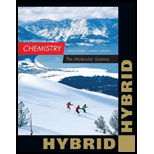
Concept explainers
Interpretation:
The molar mass and molecular formula of the compound has to be calculated.
Concept Introduction:
Boiling point is the temperature at which liquid turns into a gas. Example: boiling point of water is
Where,
TheBoiling point elevation
Where,
Molecular formula of a compound is derived from empirical formula mass and molar mass of the compound as,
Answer to Problem 72QRT
Molecular mass of the compound is
Explanation of Solution
Change in boiling point is calculated as shown below,
Given information as follows,
By substituting the known values, change in boiling point is,
Calculate molality of the unknown compound:
Substituting the values of
Calculate moles of the unknown compound:
Mass of benzene
Molar mass is calculated as shown below;
Given mass of compound is
Thus, molecular mass of the compound is
As known, the molecular formula is a multiple of the empirical formula:
The molar mass of the empirical formula
Hence,
Therefore, the molecular formula is
Want to see more full solutions like this?
Chapter 13 Solutions
Chemistry: The Molecular Science, Hybrid Edition (with OWLv2 24-Months Printed Access Card)
- What is the freezing point and normal boiling point of a solution made by adding 39 mL of acetone, C3H6O, to 225 mL of water? The densities of acetone and water are 0.790 g/cm3 and 1.00 g/cm3, respectively.arrow_forwardCalculate the molality of a solution made by dissolving 115.0 g ethylene glycol, HOCH2CH2OH, in 500. mL water. The density of water at this temperature is 0.978 g/mL. Calculate the molarity of the solution.arrow_forwardThe solubility of NaCl in water at 100 C is 39.1 g/100. g of water Calculate the boiling point of this solution. (Assume i = 1.85 for NaCl.)arrow_forward
 Principles of Modern ChemistryChemistryISBN:9781305079113Author:David W. Oxtoby, H. Pat Gillis, Laurie J. ButlerPublisher:Cengage Learning
Principles of Modern ChemistryChemistryISBN:9781305079113Author:David W. Oxtoby, H. Pat Gillis, Laurie J. ButlerPublisher:Cengage Learning Chemistry: The Molecular ScienceChemistryISBN:9781285199047Author:John W. Moore, Conrad L. StanitskiPublisher:Cengage Learning
Chemistry: The Molecular ScienceChemistryISBN:9781285199047Author:John W. Moore, Conrad L. StanitskiPublisher:Cengage Learning Chemistry & Chemical ReactivityChemistryISBN:9781133949640Author:John C. Kotz, Paul M. Treichel, John Townsend, David TreichelPublisher:Cengage Learning
Chemistry & Chemical ReactivityChemistryISBN:9781133949640Author:John C. Kotz, Paul M. Treichel, John Townsend, David TreichelPublisher:Cengage Learning Chemistry & Chemical ReactivityChemistryISBN:9781337399074Author:John C. Kotz, Paul M. Treichel, John Townsend, David TreichelPublisher:Cengage Learning
Chemistry & Chemical ReactivityChemistryISBN:9781337399074Author:John C. Kotz, Paul M. Treichel, John Townsend, David TreichelPublisher:Cengage Learning General Chemistry - Standalone book (MindTap Cour...ChemistryISBN:9781305580343Author:Steven D. Gammon, Ebbing, Darrell Ebbing, Steven D., Darrell; Gammon, Darrell Ebbing; Steven D. Gammon, Darrell D.; Gammon, Ebbing; Steven D. Gammon; DarrellPublisher:Cengage Learning
General Chemistry - Standalone book (MindTap Cour...ChemistryISBN:9781305580343Author:Steven D. Gammon, Ebbing, Darrell Ebbing, Steven D., Darrell; Gammon, Darrell Ebbing; Steven D. Gammon, Darrell D.; Gammon, Ebbing; Steven D. Gammon; DarrellPublisher:Cengage Learning Chemistry: Principles and PracticeChemistryISBN:9780534420123Author:Daniel L. Reger, Scott R. Goode, David W. Ball, Edward MercerPublisher:Cengage Learning
Chemistry: Principles and PracticeChemistryISBN:9780534420123Author:Daniel L. Reger, Scott R. Goode, David W. Ball, Edward MercerPublisher:Cengage Learning





